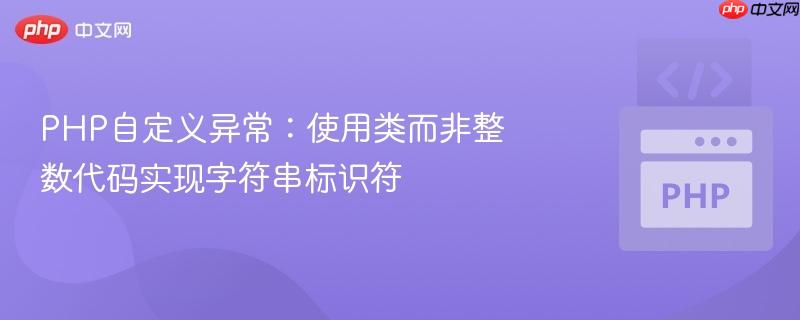
本文探讨了在PHP中如何通过自定义异常类来有效使用字符串作为异常标识符,而非受限于内置`Exception`类的整数错误码。通过构建清晰的异常继承体系,并结合PHPUnit的`expectException`方法进行测试,开发者可以实现更具描述性、可读性强且易于维护的异常处理机制,同时还能保留内部字符串标识符用于日志和调试。
在PHP中,标准的\Exception类构造函数定义为__construct(string $message = "", int $code = 0, Throwable $previous = null)。这意味着其$code参数必须是一个整数。然而,在实际开发中,我们常常希望使用更具描述性的字符串(例如"user_not_found"、"invalid_input")作为异常的唯一标识符,以便于代码审查、日志分析和单元测试。直接将字符串传递给$code参数会导致类型错误,或者需要采用变通方法,如将字符串存储在异常的“上下文”数据中,但这通常会使测试变得复杂且不够直观。
例如,开发者可能期望以下方式抛出并测试异常:
// 期望的抛出方式
throw new CustomException("user_not_found", "User not found");
// 期望的测试方式
$this->expectExceptionCode("user_not_found");然而,由于expectExceptionCode仅支持整数,这种直接的方法是不可行的。本文将介绍一种更优雅、更符合PHP面向对象原则的解决方案,即通过创建专门的自定义异常类来解决这一问题。
立即学习“PHP免费学习笔记(深入)”;
核心思想是:让异常类本身成为其“字符串标识符”。这意味着针对每一种需要特定字符串标识的错误类型,我们都创建一个独立的异常类。这样,当我们抛出或捕获某个异常时,其类名就直接传达了错误的类型。
首先,我们可以创建一个基础异常类,它继承自PHP的\Exception或\RuntimeException。这个基础类可以用来封装一些通用的行为,或者,如果确实需要,可以内部存储一个字符串标识符,用于日志或更细粒度的调试,即使它不直接用于expectExceptionCode。
<?php
namespace App\Exceptions;
use Exception;
use Throwable;
/**
* 应用程序的基础异常类,可存储一个内部字符串标识符。
*/
class AppException extends Exception
{
protected string $internalIdentifier;
/**
* 构造函数。
*
* @param string $internalIdentifier 一个唯一的字符串标识符,例如 'user_not_found'。
* @param string $message 异常消息。
* @param int $code 异常的数值代码(可选,默认为0)。
* @param Throwable|null $previous 前一个抛出的异常(可选)。
*/
public function __construct(string $internalIdentifier, string $message = "", int $code = 0, ?Throwable $previous = null)
{
parent::__construct($message, $code, $previous);
$this->internalIdentifier = $internalIdentifier;
}
/**
* 获取此异常的内部字符串标识符。
*
* @return string
*/
public function getInternalIdentifier(): string
{
return $this->internalIdentifier;
}
}
代码说明:
接下来,为每一种特定的错误情况创建继承自AppException的子类。这些子类可以预设其$internalIdentifier和默认消息。
<?php
namespace App\Exceptions;
use Throwable;
/**
* 当用户未找到时抛出的异常。
*/
class UserNotFoundException extends AppException
{
/**
* 构造函数。
*
* @param string $message 异常消息(可选,默认为“User not found”)。
* @param int $code 异常的数值代码(可选)。
* @param Throwable|null $previous 前一个抛出的异常(可选)。
*/
public function __construct(string $message = "User not found", int $code = 0, ?Throwable $previous = null)
{
// 调用父类构造函数,并传入此异常的字符串标识符
parent::__construct('user_not_found', $message, $code, $previous);
}
}
// 示例:其他可能的异常类
// class InvalidArgumentException extends AppException {
// public function __construct(string $message = "Invalid argument provided", int $code = 0, ?Throwable $previous = null) {
// parent::__construct('invalid_argument', $message, $code, $previous);
// }
// }代码说明:
现在,你可以在你的业务逻辑中抛出这些具体的异常类:
<?php
namespace App\Services;
use App\Exceptions\UserNotFoundException;
class UserService
{
public function getUserById(int $id): object
{
// 假设这是一个模拟的用户查找过程
if ($id === 100) { // 假设ID 100代表一个不存在的用户
throw new UserNotFoundException("User with ID {$id} was not found.");
}
// ... 正常逻辑返回用户对象
return (object)['id' => $id, 'name' => 'Existing User'];
}
public function deleteUser(int $id): void
{
if ($id === 100) {
throw new UserNotFoundException("Cannot delete: User with ID {$id} does not exist.");
}
// ... 删除用户逻辑
}
}针对这种自定义异常体系,PHPUnit提供了expectException方法,它允许我们断言一个特定的异常类是否被抛出。这是最强大、最清晰的测试方式。
<?php
namespace Tests\Unit;
use PHPUnit\Framework\TestCase;
use App\Services\UserService;
use App\Exceptions\UserNotFoundException;
class UserServiceTest extends TestCase
{
/**
* 测试当用户不存在时是否抛出 UserNotFoundException。
*/
public function testUserNotFoundThrowsException(): void
{
// 期望抛出 UserNotFoundException 类
$this->expectException(UserNotFoundException::class);
// 期望异常消息中包含特定文本(可选)
$this->expectExceptionMessage("User with ID 100 was not found.");
$userService = new UserService();
$userService->getUserById(100); // 这个方法会抛出 UserNotFoundException
}
/**
* 测试删除不存在用户时是否抛出 UserNotFoundException。
*/
public function testDeleteNonExistingUserThrowsException(): void
{
$this->expectException(UserNotFoundException::class);
$this->expectExceptionMessage("Cannot delete: User with ID 100 does not exist.");
$userService = new UserService();
$userService->deleteUser(100);
}
/**
* 示例:如何获取内部字符串标识符进行额外断言(如果需要)。
*/
public function testUserNotFoundExceptionHasCorrectIdentifier(): void
{
try {
$userService = new UserService();
$userService->getUserById(100);
$this->fail("Expected UserNotFoundException was not thrown.");
} catch (UserNotFoundException $e) {
// 捕获到特定异常后,可以检查其内部标识符
$this->assertEquals('user_not_found', $e->getInternalIdentifier());
$this->assertEquals("User with ID 100 was not found.", $e->getMessage());
}
}
}代码说明:
try {
// ...
} catch (UserNotFoundException $e) {
// 处理用户未找到的特定逻辑
} catch (PermissionDeniedException $e) {
// 处理权限不足的特定逻辑
} catch (\Exception $e) {
// 处理所有其他通用异常
}通过采用自定义异常类体系,我们能够优雅地解决PHP Exception类整数代码的限制,并实现使用字符串作为异常标识符的需求。这种方法不仅使代码更具描述性、可读性强,而且极大地提升了异常处理的健壮性和单元测试的效率。将异常类本身作为错误类型的标识,是PHP中处理复杂错误场景的最佳实践。
以上就是PHP自定义异常:使用类而非整数代码实现字符串标识符的详细内容,更多请关注php中文网其它相关文章!

PHP怎么学习?PHP怎么入门?PHP在哪学?PHP怎么学才快?不用担心,这里为大家提供了PHP速学教程(入门到精通),有需要的小伙伴保存下载就能学习啦!

Copyright 2014-2025 https://www.php.cn/ All Rights Reserved | php.cn | 湘ICP备2023035733号